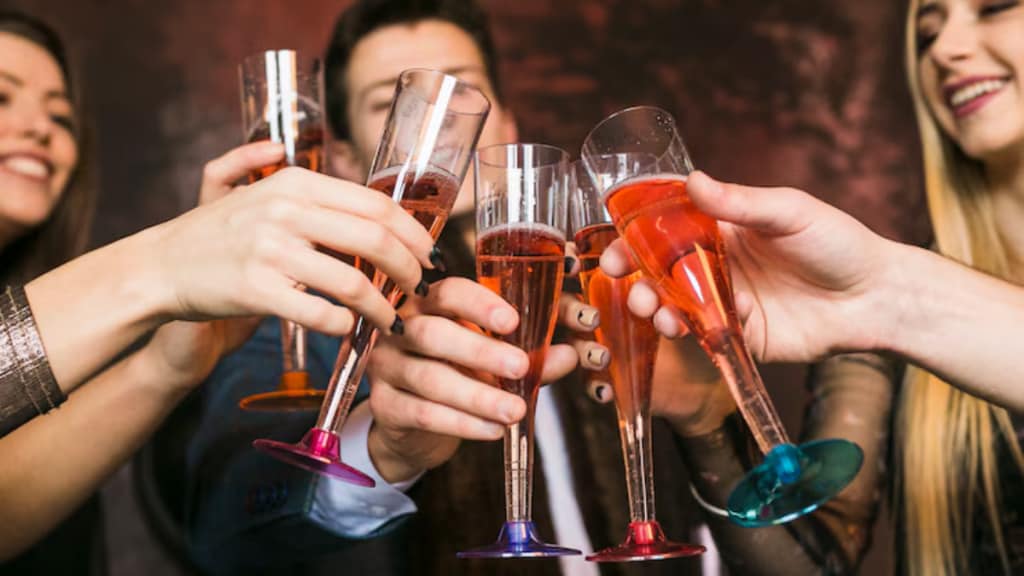Back in college, 27-year-old Aayush Mehta couldn’t imagine a Friday night without a drink in hand. But in the last two years, his bar cart has undergone a quiet transformation. Where whiskey bottles once stood, there are now sparkling teas, kombuchas, and neatly labelled “zero-alc” spritzers. “We still gather, we still vibe,” he said, “but now the high comes from great conversations, and waking up clear-headed the next morning.”
This shift in mindset is not just restricted to Ayush and his friends; reports indicate that this is a growing nationwide trend leading to a $38 billion industry as of 2022. A new wave of non-alcoholic beverages, crafted with flair and bottled in Instagram-friendly packaging, is fast becoming the drink of choice for India’s urban youth. Once seen as a niche wellness fad in Europe and the US, the “sober curious” movement is now making deep inroads into Indian cities and small towns alike.
What are non alcoholic beverages?
What exactly are non-alcoholic beverages? These drinks typically contain between 0% and 0.5% alcohol, less than a homoeopathic tincture, and span a broad range, from zero-alcohol beers and sparkling shrubs to fermented teas and botanical infusions. But the appeal goes far beyond technicalities. It’s about how they make people feel, and how they fit into a changing lifestyle.
“There’s been a powerful shift,” Ruchi Nagrecha, co-founder of Sobriety Sips, told financialexpress.com. The company manufactures and markets products like Decaf Martini, Rum Voyage, and Jungle Gin, ranging from Rs 699 to Rs 849. “I think people have simply started realising it’s okay to say no to alcohol. That’s really where the shift began. And now that there are actually great-tasting, healthier alternatives out there, the choice feels empowering. Also, let’s be honest, the next-day hangover just isn’t worth it anymore. You see it in the rise of run clubs, paddle meetups, and weekend hikes.”
Anand Ramanathan, partner at Deloitte India, noted: “India has seen a noticeable shift toward low- or no-alcohol beverages, particularly since the COVID-19 pandemic. The Deloitte Report highlights a post-pandemic surge in health consciousness, which has led consumers to seek alternatives to traditional alcoholic drinks.”
According to Deloitte, Gen Z and millennials are the primary drivers of this shift. The Deloitte Report states that these cohorts will make up 50% of India’s population by 2030 and are highly influenced by global trends, social media, and wellness narratives.
India’s $88 billion opportunity
India’s non-alcoholic beverage sector is projected to more than double to $88 billion by 2027. That’s a staggering 18% compound annual growth rate. While cola giants and juice players have long dominated the space, a new breed of brands, Coolberg, Blisswater, Sobriety Sips, and more, are reimagining what an alcohol-free drink can be.
“We’re no longer just competing with juices or CSDs,” Salloni Ghodawat, CEO of Ghodawat Consumer Ltd., which owns non-alcoholic beer brand Coolberg, added. The company offers a range of non alcoholic beers ranging from Rs 69 to Rs 125. “An entirely new category has emerged: lifestyle drinks, functional beverages, adaptogenic infusions. And the demand has surged by 30% since 2021.”
Where the movement is gaining ground
According to industry analysts, Southern India, comprising Tamil Nadu, Karnataka and Kerala, shows the highest penetration of non alcoholic beverage consumption. North Indian states like Delhi, Punjab, Uttar Pradesh and Haryana showcase the fastest Y-o-Y (Year on Year) growth. Furthermore, tier 2 and tier 3 cities across Maharashtra, Gujarat, and Rajasthan are emerging as hotbeds for experimentation, driven by rising incomes, digital exposure, and e-commerce access.
“The trend is no longer limited to Mumbai or Bangalore,” Ramanathan commented. “We’re seeing adoption spread into smaller cities. As wellness becomes aspirational and modern retail expands, consumers everywhere want better-for-you alternatives.”
What’s in a label? Quite a bit, actually
As the category matures, one challenge remains: regulation. Non-alcoholic beverages often fall into grey zones. “Some drinks are brewed like beer, bottled like wine, but contain no alcohol—so where do they go on the shelf? How are they taxed?” Nadia Sood, co-founder of Bebida Hospitality, reiterated. The company markets a range of Copenhagen Sparkling Tea, selling at Rs 2800 for a bottle. “The lack of clear labelling norms can confuse both retailers and consumers,” she added.
Terms like “alcohol-free,” “non-alcoholic,” and “low-alcohol” are often used interchangeably, though they mean different things. Ghodawat added, “It’s crucial to have clarity, not just for compliance, but to build trust with consumers.”
Not just a mocktail
Another misconception the category fights is that these drinks are somehow “lesser.” Nagrecha is quick to set the record straight. “People think it’s just a sugary mocktail. But these are complex, carefully crafted drinks, often with herbs, botanicals, and premium ingredients.”
Sood agreed: “Creating a zero-alcohol product that delivers depth and balance takes just as much, if not more, skill than traditional cocktails. It’s not a shortcut. It’s an evolution.” For a generation that cares as much about experience as about wellness, non-alcoholic beverages offer a third way: one that is social, stylish, and sustainable. And whether it’s sipping sparkling tea at a Sunday brunch or cracking open a refreshing cocktail after work, Indians are proving that a good drink doesn’t need to come with a buzz.

